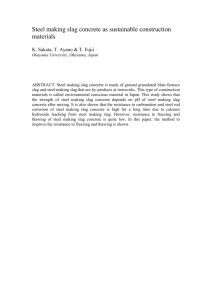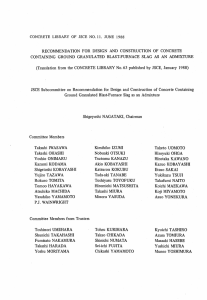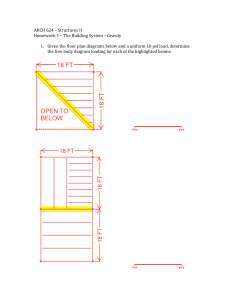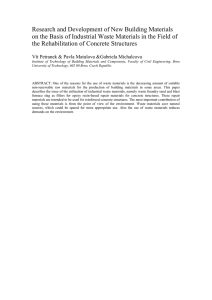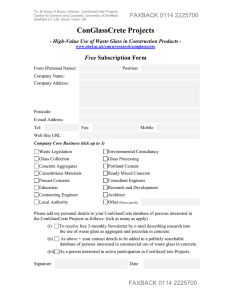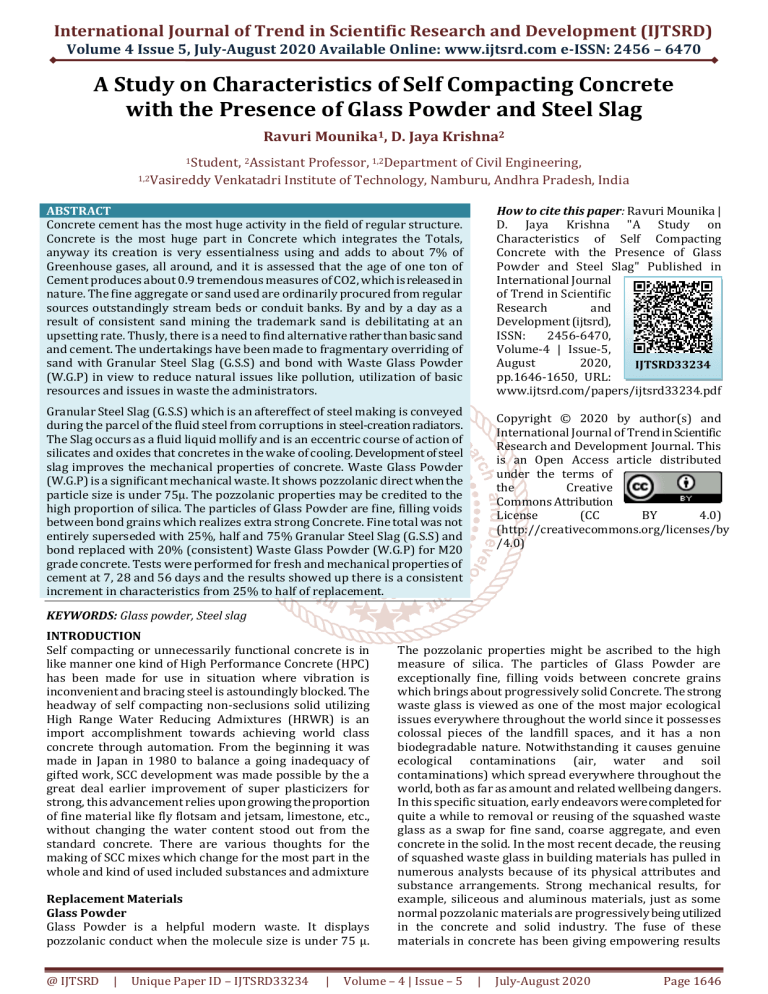
International Journal of Trend in Scientific Research and Development (IJTSRD)
Volume 4 Issue 5, July-August 2020 Available Online: www.ijtsrd.com e-ISSN: 2456 – 6470
A Study on Characteristics of Self Compacting Concrete
with the Presence of Glass Powder and Steel Slag
Ravuri Mounika1, D. Jaya Krishna2
1Student, 2Assistant
Professor, 1,2Department of Civil Engineering,
1,2Vasireddy Venkatadri Institute of Technology, Namburu, Andhra Pradesh, India
ABSTRACT
Concrete cement has the most huge activity in the field of regular structure.
Concrete is the most huge part in Concrete which integrates the Totals,
anyway its creation is very essentialness using and adds to about 7% of
Greenhouse gases, all around, and it is assessed that the age of one ton of
Cement produces about 0.9 tremendous measures of CO2, which is released in
nature. The fine aggregate or sand used are ordinarily procured from regular
sources outstandingly stream beds or conduit banks. By and by a day as a
result of consistent sand mining the trademark sand is debilitating at an
upsetting rate. Thusly, there is a need to find alternative rather than basic sand
and cement. The undertakings have been made to fragmentary overriding of
sand with Granular Steel Slag (G.S.S) and bond with Waste Glass Powder
(W.G.P) in view to reduce natural issues like pollution, utilization of basic
resources and issues in waste the administrators.
How to cite this paper: Ravuri Mounika |
D. Jaya Krishna "A Study on
Characteristics of Self Compacting
Concrete with the Presence of Glass
Powder and Steel Slag" Published in
International Journal
of Trend in Scientific
Research
and
Development (ijtsrd),
ISSN:
2456-6470,
Volume-4 | Issue-5,
August
2020,
IJTSRD33234
pp.1646-1650, URL:
www.ijtsrd.com/papers/ijtsrd33234.pdf
Granular Steel Slag (G.S.S) which is an aftereffect of steel making is conveyed
during the parcel of the fluid steel from corruptions in steel-creation radiators.
The Slag occurs as a fluid liquid mollify and is an eccentric course of action of
silicates and oxides that concretes in the wake of cooling. Development of steel
slag improves the mechanical properties of concrete. Waste Glass Powder
(W.G.P) is a significant mechanical waste. It shows pozzolanic direct when the
particle size is under 75μ. The pozzolanic properties may be credited to the
high proportion of silica. The particles of Glass Powder are fine, filling voids
between bond grains which realizes extra strong Concrete. Fine total was not
entirely superseded with 25%, half and 75% Granular Steel Slag (G.S.S) and
bond replaced with 20% (consistent) Waste Glass Powder (W.G.P) for M20
grade concrete. Tests were performed for fresh and mechanical properties of
cement at 7, 28 and 56 days and the results showed up there is a consistent
increment in characteristics from 25% to half of replacement.
Copyright © 2020 by author(s) and
International Journal of Trend in Scientific
Research and Development Journal. This
is an Open Access article distributed
under the terms of
the
Creative
Commons Attribution
License
(CC
BY
4.0)
(http://creativecommons.org/licenses/by
/4.0)
KEYWORDS: Glass powder, Steel slag
INTRODUCTION
Self compacting or unnecessarily functional concrete is in
like manner one kind of High Performance Concrete (HPC)
has been made for use in situation where vibration is
inconvenient and bracing steel is astoundingly blocked. The
headway of self compacting non-seclusions solid utilizing
High Range Water Reducing Admixtures (HRWR) is an
import accomplishment towards achieving world class
concrete through automation. From the beginning it was
made in Japan in 1980 to balance a going inadequacy of
gifted work, SCC development was made possible by the a
great deal earlier improvement of super plasticizers for
strong, this advancement relies upon growing the proportion
of fine material like fly flotsam and jetsam, limestone, etc.,
without changing the water content stood out from the
standard concrete. There are various thoughts for the
making of SCC mixes which change for the most part in the
whole and kind of used included substances and admixture
Replacement Materials
Glass Powder
Glass Powder is a helpful modern waste. It displays
pozzolanic conduct when the molecule size is under 75 µ.
@ IJTSRD
|
Unique Paper ID – IJTSRD33234
|
The pozzolanic properties might be ascribed to the high
measure of silica. The particles of Glass Powder are
exceptionally fine, filling voids between concrete grains
which brings about progressively solid Concrete. The strong
waste glass is viewed as one of the most major ecological
issues everywhere throughout the world since it possesses
colossal pieces of the landfill spaces, and it has a non
biodegradable nature. Notwithstanding it causes genuine
ecological contaminations (air, water and soil
contaminations) which spread everywhere throughout the
world, both as far as amount and related wellbeing dangers.
In this specific situation, early endeavors were completed for
quite a while to removal or reusing of the squashed waste
glass as a swap for fine sand, coarse aggregate, and even
concrete in the solid. In the most recent decade, the reusing
of squashed waste glass in building materials has pulled in
numerous analysts because of its physical attributes and
substance arrangements. Strong mechanical results, for
example, siliceous and aluminous materials, just as some
normal pozzolanic materials are progressively being utilized
in the concrete and solid industry. The fuse of these
materials in concrete has been giving empowering results
Volume – 4 | Issue – 5
|
July-August 2020
Page 1646
International Journal of Trend in Scientific Research and Development (IJTSRD) @ www.ijtsrd.com eISSN: 2456-6470
with respect to the mechanical and strength properties of
cement.
Notwithstanding the presence of a lot of modern waste, for
example, impact heater slag, fly debris, silica smoke, slag and
rural buildups, for example, rice husk debris, which have
been utilized for a long time in enormous sum as crude
materials and segments in the concrete business, there are
as yet numerous other mechanical squanders not utilized at
this point, for example, squander glass. Indeed a couple of
studies have effectively examined the possible utilization of
finely ground squander glass as a pozzolanic material
concentrating on quality turn of events and soluble base
silica reactivity.
Glass is the aftereffect of the merger of a few inorganic
mineral crude materials, which subsequent to experiencing a
procedure of controlled cooling turns into a hard,
homogeneous, steady, dormant, undefined and isotropic
material. In light of the significant sythesis, glass can be
grouped into a few classes yet soft drink lime glass is the
most generally used to make compartments, buoy and sheet
glass and in this way making over 80% by weight of waste
glass.
Steel Slag
Steel slag, the result of steel and iron creation is created in
huge amounts every day, and these items are viewed as risky
and dangerous for both the manufacturing plants and the
earth. In 2016, over 100million huge amounts of steel slag
were delivered in China, and the sum is expanding each year,
while the absolute usage proportion of steel slag is just 10%.
The collection of steel slag not just takes up a huge zone of
land, yet additionally contaminates the general condition. To
investigate the use of steel slag, reusing advancements to
utilize steel slag as development material have gotten
expanding consideration.
Likewise, steel slag has been generally utilized as total in
solid, that is steel slag total cement. A few investigations
exhibited that the utilization of steel slag as fine total in
concrete improves the mechanical properties of solidified
cement. The utilization of steel slag as fine total in concrete
blends positively affects both the compressive and malleable.
Fig-1. Disposal of industrial glass waste
Properties of Glass Powder
a)Physical Properties:Fig-2. Glass powder
Fig-3Granular Steel Slag
Table 1.1: Physical Properties of Glass Powder
Properties
Values
Specific gravity 2.71
Surface area
2120 cm2/g
6
Fineness
@ IJTSRD
|
Unique Paper ID – IJTSRD33234
|
Volume – 4 | Issue – 5
|
July-August 2020
Page 1647
International Journal of Trend in Scientific Research and Development (IJTSRD) @ www.ijtsrd.com eISSN: 2456-6470
% Replacement Vs Slump Flow Values in mm
% Replacement Vs J-Ring Test Values in mm
% Replacement vs. V-Funnel Time in secs
@ IJTSRD
|
Unique Paper ID – IJTSRD33234
|
Volume – 4 | Issue – 5
|
July-August 2020
Page 1648
International Journal of Trend in Scientific Research and Development (IJTSRD) @ www.ijtsrd.com eISSN: 2456-6470
balancing enormous amounts of concrete and regular
totals. This may lessen ecological issues and land fill
issues notwithstanding bringing down the solid creation
cost.
The created cement might be utilized for private
development, where moderate compressive quality of
cement is wanted. Be that as it may, sturdiness of solid
should be examined to check its presentation against
corrosive assault, sulfate assault, freezing and defrosting
and so forth before application.
% Replacement Vs Blocking Ratio in mm
CONCLUSIONS:
This examination was done to research the joined impact of
G.P and S.S supplanting concrete and F.A, on Fresh and
Hardened Properties of SCC. Following ends were surmised
from the test outcomes:
The usefulness of cement is more with expansion of
Glass Powder content which might be because of
improved pressing thickness with fuse of G.P.
Workability diminishes continuously with the expansion
in Granular Steel Slag content i.e.; (25%, half, and 75%)
which might be credited to the permeable and
unpleasant surface of Steel Slag.
Compressive Strength, Split Tensile Strength, Flexural
Strength increments with the expansion in Granular
Steel Slag content at steady degree of Glass Powder up
to half of Steel Slag which might be expected to the
pozzolanic activity of Steel Slag Aggregates or
distinction in hardness of Steel Slag and supplanted
totals.
The rate variety of compressive quality is 2.35% at M1,
7.35% at M2, 20.58% at M3, 13.53% at M4 for 7 days
and 2.16% at M1, 7.23% at M2, 12.7% at M3, 10.45% at
M4 for 28 days and 2.26% at M1, 11.4% at M2, 17.96%
at M3, 14.73% at M4 for 56days regarding M0 Mix.
The most extreme increment in Compressive quality is
20.58% at 7days, 12.7% at 28days and 17.96% at
56days for M3 Mix individually.
The rate variety of Split Tensile Strength Test is 2.36%
at M1, 6.3% at M2, 28.34% at M3, 11.02% at M4 for 7
days and 2.86% at M1, 6.2% at M2 20.95% at M3,
12.38% at M4 for 28 days and 3.3% at M1, 5.8% at M2,
24% at M3, 12.4% at M4 for 56 days regarding M0 Mix.
For Split Tensile Test the most extreme increment is
28.34% at 7 days, 20.95% at 28 days and 24% at 56
days for M3 Mix individually.
The rate variety of Flexural Strength Test is 1.26% at
M1, 9.7% at M2, 35.02% at M3, 22.36% at M4 for 7 days
and 2.22% at M1, 6.66% at M2, 24.5% at M3, 15.55% at
M4 for 28 days and 2.5% at M1, 6.77% at M2, 24.8% at
M3, 16.05% at M4 for 56days regarding M0 Mix.
For Flexural Strength the most extreme increment is
35.02% at 7 days, 24.5% at 28 days and 24.8% at 56
days for M3 Mix individually.
The squander materials for example Glass Powder and
Granular Steel Slag may successfully be used in
development industry for the creation of cement,
@ IJTSRD
|
Unique Paper ID – IJTSRD33234
|
REFERENCES
[1] A. A. Aliabdo, A. E. M. A. Elmoaty, A. Y. Aboshama,
Utilization of waste glass powder in the production of
cement and concrete, Construction and Building
Materials 124 (2016), P.P 866–877.
[2] Ahmed Omran, Arezki Tagnit-Hamou, Performance of
glass-powder concrete in field applications,
Construction and Building Materials 109 (2016), P.P
84– 95.
[3] Ana Mafalda Matos, Joana Sousa Coutinho, Durability of
mortar using waste glass powder as cement
replacement, Construction and Building Materials 36
(2012), P.P 205–215.
[4] C. Venkata subramanian, The influence of combination
of crushed waste glass powder (GP) and ground
granulated blast furnace slag (GGBS) as a partial
replacement in cement, on the behaviour of mechanical
and durability properties of concrete, Construction and
Building Materials 156 (2017), P.P 739–749.
[5] E. Anastasiou, K. G. Filikas, M. Stefanidou, Utilization of
fine recycled aggregates in concrete with fly ash and
steel slag, Construction and Building Materials. 50
(2014), P.P 154–161.
[6] Esraa Emam Ali, Sherif H. Al-Tersawy, Recycled glass as
a partial replacement for fine aggregate in self
compacting concrete, Construction and Building
Materials 35 (2012), P.P 785–791.
[7] G. M. Sadiqul Islam, M. H. Rahman, Nayem Kazi, partial
replacement of waste glass powder with cement for
sustainable concrete practices, International Journal of
Sustainable Built Environment (2017), P.P 37–44.
[8] Ivanka Netinger, Damir Varevac, Dubravka Bjegovic,
Dragan Moric, Effect of high temperature on properties
of steel slag aggregate concrete, Fire Safety Journal 59(
2013), P.P 1-7.
[9] M. M. Younes, H. A. Abdel Rahman, Magdy M. Khattab,
Utilization of rice husk ash and waste glass in the
production of ternary blended cement mortar
composites, Journal of Building Engineering 20 (2018),
P.P 42–50
[10] Nurul Hidayah Roslan, Mohammad Ismail, Zaiton Abdul
Majid, Seyedmojtaba Ghoreishiamiri, Bala Muhammad,
Performance of steel slag and steel sludge in concrete,
Construction and Building Materials 104 (2016),P.P
16–24.
[11] Wang Qiang, Yan Peiyu, Yang Jianwei, Zhang Bo,
Influence of steel slag on the mechanical properties
and durability of concrete, Construction and Building
Materials 47 (2013), P.P 1414-1420.X. Yu, Z. Tao, T.Y.
Volume – 4 | Issue – 5
|
July-August 2020
Page 1649
International Journal of Trend in Scientific Research and Development (IJTSRD) @ www.ijtsrd.com eISSN: 2456-6470
Song, Z. Pan, Performance of concrete made with steel
slag and waste glass, Construction and Building
Materials. 114 (2016), P.P73746.
[12] Jian-xin Lu, Zhen-hua Duan, Chi Sun Poon, Fresh
properties of cement pastes or mortars incorporating
waste glass powder and cullet, Construction and
Building Materials 131 (2017), P.P 793-799.
[13] Yongchang Guo, Jianhe Xie, Wenyu Zheng, Jianglin Li,
Effects of steel slag as fine aggregate on static and
@ IJTSRD
|
Unique Paper ID – IJTSRD33234
|
impact behaviours of concrete, Construction and
Building Materials 192 (2018), P.P 194–201.
[14] IS 456: 2000, recommended code of practice for plain
and reinforced concrete, Bureau of Indian Standard,
New Delhi.
[15] IS 10262- 2009, Recommended guide lines for concrete
mix, Bureau of Indian Standard, New Delhi.
[16] Specification and Guidelines for Self-Compacting
Concrete by EFNARC, 2005.
Volume – 4 | Issue – 5
|
July-August 2020
Page 1650

